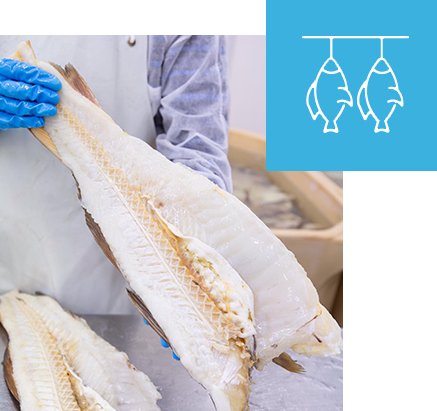
long-life excellence
Stockfish and klippfisch are cod products. The old methods of preserving, which vary, add unique flavour and consistency characteristics that set these products apart from fresh fish
The major difference between stockfish and klippfisch is that the former is dried, and the latter preserved in salt.

Norway is the only country in the world that that produces stockfish.
Production is linked to the codfishing season (between February and April) in northern Norway (the Lofoten islands).
The catch is immediately processed (removal of the heads, gutting, washing and rack drying for about three months between February and June).
The drying process is natural, achieved solely by exposure to the sunlight and wind. The rain makes for a gradual process that therefore conserves all the nutritional properties of the cod.
Due to changes in weather conditions influencing the quality of the product, only rarely (if at all) can the same production levels be maintained from year to year.
In mid-June the selector (the vrakeren, a historical craftsperson of fundamental importance) engages in the task of separating the fish to make up a number of categories on the basis of certain size criteria (length, size and weight), and the quality (first and second grade).
2/3 of Norway’s stockfish.
Due to cultural and historical factors, the Italian market breaks down into five major zones: Venetia, Liguria, Campania, Calabria and Sicily. Stockfish is less popular in the other regions (with the exceptions of the two cities, Livorno and Ancona, that are traditionally longstanding consumers).
The methods of preparation of this product vary from region to region. Consumers must therefore purchase the right kind of stockfish.
Before cooking, the stockfish must be “softened” by soaking in water for at least one week. Consumers generally buy it in already cookable form.
In north-eastern Italy, people prefer a leaner fish, which is beaten to “recover” it. The preference elsewhere is for a fattier fish, which is “recovered” as a whole piece, After softening for a few days it is then divided up.
These are the products of the Gadus Morhua or Gadus Macrocephalus cod, obtained by salting and seasoning.
The head is removed and the fish is gutted. The fish is cut open “a farfalla” or butterfly style (from the belly to the tail). It is washed and placed in a strong brine for a week.
It is then placed on a pallet between layers of salt. It is left to season for three to four weeks, and then packaged in 25-Kg containers with considerable amounts of salt, preserving this product for about two years.
The process for the large fillets does not change. However, the backbone is removed.


The process is as for salted klippfisch. However, after seasoning under salt, this product is placed in special warm air drying tunnels for six/seven days.
Removing the water in the flesh means less salt is required to preserve this klippfisch, which has a more marked flavour and colour than salted klippfisch.
For climatic and environmental reasons, production of the St John’s klippfisch can only take place on the Gaspé island in Canada (just as the stockfish can only be produced in Norway’s Lofoten islands).
Processing entails the methods used for salted klippfisch and stockfish (salting and drying).
After being cut open “a farfalla” or butterfly style, the fish is seasoned in a mild brine (the formula is a “secret”). It is then dried in the air (exposed to sunlight on a promontory overlooking the Atlantic).
All types of klippfisch must be soaked in cold water before cooking, to remove the salt and rehydrate the fibres.
The time required for soaking shall depend on the type and size of the klippfisch:
- Klippfisch salted and not dried/salted
to be soaked for 3/4 days - Large klippfisch fillets not dried/salted
to be soaked for 2/3 days - Dry, dried lightly salted klippfisch
to be soaked for 3/4 days - Baccalà San Giovanni “Gaspé” (St John’s klippfisch) very dry, very lightly salted klippfisch
to be soaked for 5/6 days - Stockfish, completely dried/without salt
to be soaked for 8/10 days